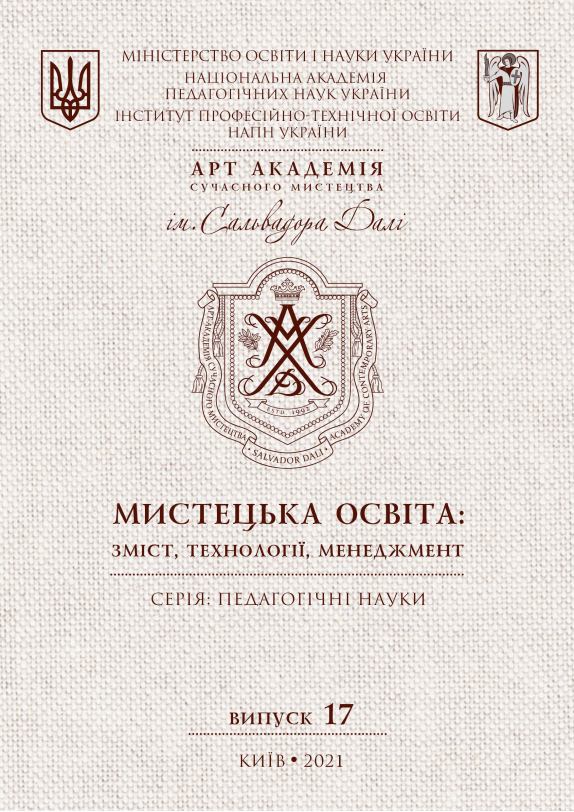MYKOLA STOROZENKO’S SPIRITUAL CONCEPTUALISM IN THE ART WORKS OF EDUARD NIKONOROV
Abstract
The presented article is devoted to pour light on ways of transferring artistic experience from teacher to student, to analize deeply of artistic potential and cooperation of the talented artist Mykola Storozhenko and his follower Eduard Nikonorov. The subject of the research is the artistic heritage of Eduard Nikonorov who was a student of the Ivano-Frankivsk postmodernist artist Mykola Storozhenko. The presented article reflects influence of Mykola Storozhenko's school on the formation of the Eduard`s artistic personality, especially the influence of artistic methods on the formation of professional art features of young artist during different stages of learning. The principles of a teacher's work and teaching in the range from the simplest tasks to complex staging compositions are figured out in this research as well. The artistic process is created in the worldview concept of Mykola Storozenko that contains the remote sphere of material and spiritual, and their association with the Renaissance tradition. The individual approach of the teacher led to the emergence of a system of artistic values, special expressiveness of the image due to the colorful techniques of work. Reality is duplicated in another dimension, where the transformation of material form takes place. The purpose of achieving unconditional harmony is a way to reveal the essence of things, to strive for the formation of high level and it is quite felt in the art of teacher and his student. The manner of presenting the image is recognizable even today among the pupils of Storozhenko's school, because in their arts are distinguishe places of charisma of their teacher-founder, who managed to sacrefy the idea of beauty in the formula “man–world-God”. The philosophy of beauty, developed by Mykola Storozenko, became the motivation for Eduard Nikonorov's artistic experiments in the period of mature creativity.
References
Гатальська С. М. Філософія культури: підручник. Київ : Либідь, 2005. 328 с.
Гоголь В. Д. Інтуїтивне і раціональне в творчості художника. Вісник Національного університету «Львівська політехніка». Серія «Архітектура». Т. 1, № 1, 2019. С. 154–162.
Зубавіна І. Б. Світоглядні засади творчості Миколи Стороженка. Микола Стороженко – художник, педагог, людина: зб. тез доповідей наук.-практ. конф., Київ, 08 листопада 2018 р. С. 9–10.
Иваницкий М. Ф. Школа изобразительного искусства: учеб.-метод. пособ. Москва : Из-ное искусство, 1989. 200 с.
Муляр Л. Навчально-творча майстерня живопису і храмової культури проф. М. А. Стороженка в національній Академії образотворчого мистецтва та архітектури (Київ): тенденції та перспективи. Вісник ХДАДМ. № 4. 2008. С. 75–80.
Петрук Р. Останній твір Миколи Стороженка. Актуальні питання гуманітарних наук: міжвузівський збірник наукових праць молодих вчених Дрогобицького державного педагогічного університету імені Івана Франка. Вип. 35, Т 4, 2021. С. 79–90.
Прохорова Н. А. Академічний рисунок як фундамент творчої грамотності для формування творчої особистості. АРТ-ПРОСТІР: наук. ж-л. Київ : КУБГ, 2016. Вип. 2. С. 99–102.
Сидор М. Аспекти пізнання та оволодіння художнім рисунком к виразною формою професійного поступу художника. Молодь і ринок: науково-педагогічний журнал Дрогобицького державного педагогічного університету ім. І. Франка. № 8(163). Дрогобич, 2018. С 54–59.
Стороженко М. Думки під склепінням (щодо мистецькості сакральних творів) Образотворче мистецтво. №2. 2001 С.66–71.
Copyright (c) 2021 Марія Дяків

This work is licensed under a Creative Commons Attribution-NonCommercial 4.0 International License.

